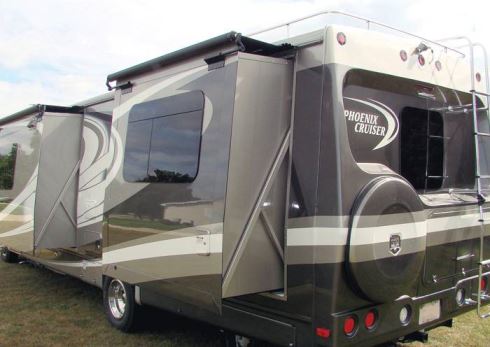A multitude of features in a smaller package.
By Gary Bunzer
April 2012
Phoenix USA, of Elkhart, Indiana, is out to prove you don’t have to give up features and amenities while enjoying the motorhome lifestyle on a smaller scale. In fact, as many buyers have discovered, a smaller motorhome may mean a lower initial investment, improved fuel economy, and a bevy of features that contribute to the total RV experience.
Today’s offerings presented by Phoenix Cruiser indeed set this company apart and will nudge anyone considering the move to a smaller coach, or those just entering the RV lifestyle, to take a serious look.
I’ve watched this company grow over the years and am quite pleased to see how it has evolved. I had the chance to personally inspect several Phoenix Cruiser models at a recent RV show, and I was immediately drawn to the Model 2910 — in particular, the 2910T, a triple-slideout unit that measures 30 feet 6 inches long. (Similarly, the 2910D features two slideouts.) The design team at Phoenix Cruiser has mastered the art of providing form and functionality in a wonderful floor plan.
This type of motorhome is often referred to as a “super B” or “B-plus” motorhome, because it does employ a cutaway van chassis, but it eliminates the large, cab-over bed above the cockpit. Instead, a beautifully functional entertainment system is housed in that area and the cab-over section is reduced to a streamlined, aerodynamic front cap that begins just above the windshield line and ends where it mates perfectly with a one-piece fiberglass roof.
Exterior Features
The main entry door of the 2910T is positioned just rearward of the curbside slideout, in which is nestled the convertible dinette section. Featuring a sliding screen panel, the entry door is designed and contoured to match the sidewall for aerodynamic consistency. It seals tightly without the risk of water intrusion — a common occurrence with some curved sidewall designs.
The disappearing flexible screen panel resists inward or outward pressure, such as might occur with an overeager pet ready for its morning walk.
Below the curbside slideout are a storage bay and a separate compartment that houses the twin, deep-cycle house batteries. Similar to what’s often found in Type A motorhomes, the batteries are mounted in an easy-access slide-out tray. From a technical standpoint, this is important. Many times batteries in smaller motorhomes are buried, making hydration impossible without complete removal of at least one battery. This is but one of many added-value features I found on this model.
Immediately past the entry door and just forward of the rear axle is the lower vent/access panel for the refrigerator. In addition, a GFCI-protected 120-volt-AC receptacle is mounted below the refrigerator. The six-gallon, direct-spark-ignition water heater is located aft of the rear axle and forward of a distinctive storage compartment/ice chest — a Phoenix Cruiser hallmark.
For stowing taller items, a flip-up, hinged “shelf” or “floor” is lifted and secured inside this compartment. A convenient box suitable for smaller items is mounted to a sliding track and positioned below; it can double as an ice chest, allowing for some great tailgating possibilities.
An optional electric patio awning and a slideout awning nicely complete the curbside view of our subject coach. Now, let’s move to the driver’s side.
Should the buyer choose, a 4,000-watt Onan generator can be tucked into its own compartment below the forward slideout, just behind the driver’s cab door. Another large storage compartment is mounted next to the generator. Farther back on the driver’s side, the intake/exhaust assembly for the 30,000-Btu forced-air furnace is located just above the propane compartment, along with the chassis fuel fill, cable connections, and an exterior shower compartment.
Directly below the rear bedroom slideout is the plumbing bay, replete with a Sani-Con macerator system, a standard feature on all Phoenix Cruiser models. The black water and gray water holding tanks are equipped with fresh water flush valves, and both tanks are heated for winter use. In addition to the macerator system, a three-inch dump outlet is included with electric gate valves on both tanks. The city water connection and an auxiliary water pump switch are also located in the plumbing bay.
The rear of the motorhome features another Phoenix Cruiser hallmark: the iconic, molded (and lockable) fiberglass spare tire cover. An oversized storage bay is mounted just to the right of the spare tire. Inside you’ll find the detachable 30-amp shoreline power cord and ample room for a lot of gear.
The exterior construction technique employs a vacubonded, laminated fiberglass gel coat over 1 1/2-inch-thick sidewalls of tubular aluminum sandwiched with block foam insulation in all of the voids. The floor of the motorhome is 2 inches thick and framed with tubular steel. In fact, metal framing surrounds every single opening in the roof and sidewalls; another added-value feature. (Some motorhomes have wooden radiused corners or none at all.) In addition, real moisture-proof plywood is used as the subfloor. You won’t find OSB (oriented strand board) anywhere in a Phoenix Cruiser. A 1/4-inch fluted plastic sheet protects the entire underbelly of the floor.
One noteworthy construction feature most prospective buyers may not be aware of is the use of what Phoenix Cruiser calls “rubber pucks,” which are mounted between the steel frame of the chassis and the bottom of the subfloor. Positioned strategically, these rubber vibration dampeners allow for a smoother ride and less noise while traveling.
Another technical practice I appreciate is the fact that during construction, the conductors for all the electrical circuits remain contiguous throughout the coach. In other words, there are no splices or segmented harnesses within the wiring when the various sections of the motorhome come together. Why is this important? Well, for one thing, the more electrical connections in any circuit, the better the chances of developing corrosion-induced open circuits and vibration faults. When electrical connectors are employed inside ceiling or wall voids, troubleshooting electrical anomalies can become time-consuming (read: expensive). Kudos to Phoenix Cruiser for making it easier for service techs and RV owners!
Other exterior features include tinted frameless windows; the bottom section cranks out, awning-style, allowing for ventilation even during a rainstorm. Full-body paint schemes are available, with 12 different options. The dual rear tires are equipped with stainless-steel valve extenders. A solid, one-piece fiberglass roof tops off the 2910 along with a roof rack and an access ladder.
Exterior Chassis Features
Our subject coach has as its foundation the Ford E-450 chassis, powered by the revered 6.8-liter, V-10 gasoline engine. (The 2350 and 2400 models are available on the venerable Sprinter chassis, pulled along by a 3.0-liter, V-6 turbo-diesel engine.)
The Ford chassis features a hefty chrome grille and bumper and a 5,000-pound PullRite hitch receiver. Yes, it is quite possible to tow a car or boat behind this motorhome. Other chassis highlights on our subject coach include hidden fiberglass running boards that magically appear when the door is opened, mirror-mounted auxiliary turn signal lamps, a backup camera/monitor system, and HWH hydraulic levelers, among many other available options.
Interior Features
Stepping inside the Phoenix Cruiser 2910T gives one the sense of being in a much larger motorhome. The opposing slideouts in the main living section certainly add to that sensibility, but the coach simply looks and feels much larger than it actually is.
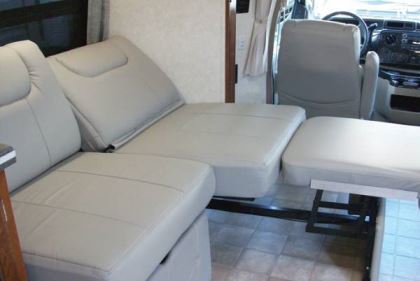 Let’s start in the cab. Equipped with factory heating and air-conditioning, in-dash stereo/CD player, driver and passenger air bags, cruise control, tilt wheel, and power windows and door locks, it would look like any other Ford van chassis were it not for the custom dash panels and trimwork — utilitarian, perhaps, but with the right amount of splash to add distinction to the Phoenix Cruiser. A fully pleated privacy curtain wraps the cockpit at night. The driver’s perch is a six-way power seat, more common to larger motorhomes. To add to the homeyness and for an intimate setting, the copilot’s seat swivels to face the living section.
Let’s start in the cab. Equipped with factory heating and air-conditioning, in-dash stereo/CD player, driver and passenger air bags, cruise control, tilt wheel, and power windows and door locks, it would look like any other Ford van chassis were it not for the custom dash panels and trimwork — utilitarian, perhaps, but with the right amount of splash to add distinction to the Phoenix Cruiser. A fully pleated privacy curtain wraps the cockpit at night. The driver’s perch is a six-way power seat, more common to larger motorhomes. To add to the homeyness and for an intimate setting, the copilot’s seat swivels to face the living section.
Directly above the cab in the unit I inspected is the optional entertainment package, which consists of a Samsung 26-inch LCD television, a DVD player, a receiver, and an amplified surround-sound system.
As mentioned earlier, the forward curbside slideout houses the convertible dinette under a bank of overhead cabinets. Contributing to the abundant storage found inside, full-depth drawers on ball-bearing glides are installed below the dinette’s twin bench seats. The dinette table, as well as the countertop extension, is made of solid wood.
Directly across from the dinette slideout is a slightly longer slide room that ensconces a very comfortable electric sofa bed measuring a full 54 inches by 74 inches. The electric controls allow partial extension of the sofa bed to a more lounger-like position. Overhead cabinets stretch across the top of the sofa bed in this slideout as well. The slideout also incorporates a recessed two-burner cooktop with a convection-microwave oven mounted directly above. The galley cabinet below the cooktop contains a stack of three large, full-extension drawers and a nifty wooden cutting board, all mounted on ball-bearing drawer glides. Directly below the cutting board are two more drawers for oversized cooking gear.
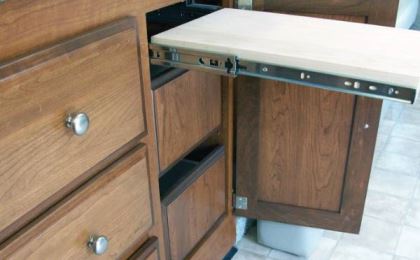 |
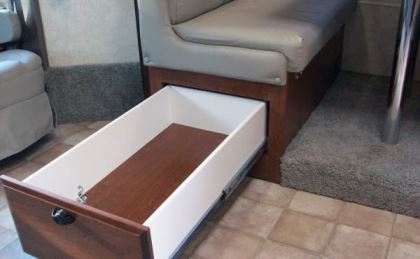 |
A sink and cabinet are positioned perpendicular to the cooktop cabinet mounted in the slide room, making for a larger-than-expected feel to the whole galley section. Whether by design or simple happenstance, this offset approach makes for a very comfortable workspace for any budding gourmet chef. The flip-up extension table adds more working area. Cabinets are hung above the sink as well, while switches for the water pump, water heater, and holding tank heaters are conveniently mounted just below the sink countertop. A large, two-door absorption refrigerator is positioned directly across the aisle from the galley sink.
A full-size bathroom consisting of the toilet, lavatory sink, and expansive medicine cabinet is farther down the main aisle on the road side of the coach, with a separate full shower enclosure just across the aisle. Again, this setup is typically more congruent with larger motorhomes.
In the bedroom, a queen-size bed with a memory-foam mattress is positioned in the street-side slideout. The bed faces twin wardrobe cabinets on either side of a work desk. A tilting 15-inch LCD television is mounted in an overhead cabinet. One of my pet peeves with mounted bedroom televisions is the inability to achieve a comfortable viewing angle from a supine position. Not so with the Phoenix Cruiser; watching television from the bed proved quite comfortable. Another bank of overhead cabinets is mounted directly above the bed, also nestled in the slideout room.
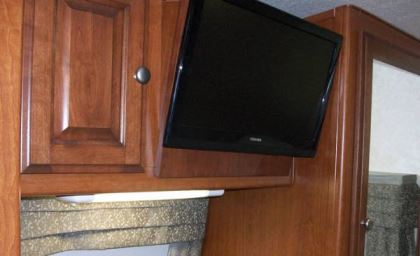 The cabinetry in our subject coach featured rich, raised-panel cherry wood doors with impeccable fit-and-finish detail throughout all the woodwork. All galley and lavatory countertops have stylish solid surfaces for ease of cleaning. In addition, all windows were dressed with decorative valances and day/night shades, also more indicative of larger motorhomes. The vinyl flooring is padded from stem to stern and runs unabated from the rear wall to the cab.
The cabinetry in our subject coach featured rich, raised-panel cherry wood doors with impeccable fit-and-finish detail throughout all the woodwork. All galley and lavatory countertops have stylish solid surfaces for ease of cleaning. In addition, all windows were dressed with decorative valances and day/night shades, also more indicative of larger motorhomes. The vinyl flooring is padded from stem to stern and runs unabated from the rear wall to the cab.
Electrically, the 2910 Phoenix Cruiser is equipped with 30-amp shoreline service, a 120-volt-AC panel board, and a 1,800-watt Xantrex inverter/battery charger. As mentioned earlier, our subject coach was also outfitted with the third method of providing AC power, an onboard Onan generator. A Fan-Tastic Vent fan is also available among a plethora of listed options.
DC controls for the monitor panel, the remote generator start/stop switch, the slideout switches, and the Xantrex panel are mounted on the bulkhead just behind the driver’s seat.
Controls for the optional electric awning, entry step, porch lamps, and the house battery disconnect solenoid are mounted on the cabinet wall just inside the entry door. Likewise, the combination propane leak detector/CO monitor and fire extinguisher are located just inside the entry door at floor level.
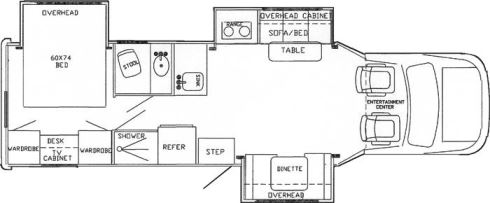 Phoenix Cruiser motorhomes are available at factory outlet stores in Albuquerque, New Mexico; Punta Gorda, Florida; and at the manufacturing headquarters in Elkhart, Indiana. Available in four interior color themes and, as noted, 12 exterior paint schemes, the nine coaches in the 2012 Phoenix Cruiser line warrant serious consideration from any current RV owner seeking to downsize and from any couple just entering the RV lifestyle.
Phoenix Cruiser motorhomes are available at factory outlet stores in Albuquerque, New Mexico; Punta Gorda, Florida; and at the manufacturing headquarters in Elkhart, Indiana. Available in four interior color themes and, as noted, 12 exterior paint schemes, the nine coaches in the 2012 Phoenix Cruiser line warrant serious consideration from any current RV owner seeking to downsize and from any couple just entering the RV lifestyle.
What struck me most during my tour of the 2910T, aside from the distinct styling and color scheme, were the abundant storage space, the attention to detail, and the general feel of a much larger motorhome. In fact, the most common complaint about any motorhome is usually “not enough storage space.” I believe the Phoenix Cruiser 2910T will surprise many people.
AT A GLANCE
MANUFACTURER
Phoenix USA, 2601 Marina Drive, Elkhart, IN 46514; (877) 754-8535, (574) 266-2020; www.phoenixcruiser.com
MODEL
Phoenix Cruiser
FLOOR PLAN
2910T (triple-slideout)
CHASSIS/ENGINE
Ford E-450
EXTERIOR LENGTH
30 feet 6 inches
EXTERIOR WIDTH
93 inches
INTERIOR HEIGHT
6 feet 4 inches
EXTERIOR HEIGHT
10 feet 1 inch with roof A/C
GROSS VEHICLE WEIGHT RATING (GVWR)
14,500 pounds
GROSS COMBINATION WEIGHT RATING (GCWR)
22,000 pounds
FRESH WATER CAPACITY
46 gallons
HOLDING TANK CAPACITIES
gray water — 35 gallons;
black water — 23 gallons
FUEL CAPACITY
55 gallons
PROPANE CAPACITY
42 pounds
HEATING AND AIR-CONDITIONING
30,ooo-Btu furnace; 13,500-Btu A/C with 7,000-Btu electric heat
WARRANTY
coach — 12 months/12,000 miles;
chassis — 3 years/36,000 miles;
powertrain — 5 years/60,000 miles
BASE MANUFACTURER’S SUGGESTED RETAIL PRICE
$79,995

